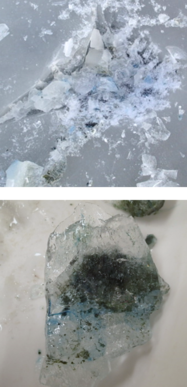 Love is in the air this Valentine's Day, but for cyanobacteria, a lackluster love life is all that awaits...
Since blue-green algae are actually bacteria (cyanobacteria), they reproduce asexually. Cyanobacteria that grow as colonies of single cells, such as the common genus Microcystis, reproduce by fission, or the splitting of an individual cell into two or more cells. Filamentous forms of cyanobacteria, like the genus Planktothrix, also reproduce via fragmentation, where a filament made up of cells breaks apart to form shorter filaments. These shorter filaments later develop into full-length filaments. Blooms are the result of fast cyanobacterial reproduction when growing conditions are just right.
Photos courtesy of Gina LaLiberte, Applied Limnologist at the Wisconsin Department of Natural Resources.
Which factors promote cyanobacterial blooms in a water body?
The following factors promote cyanobacterial reproduction, which can result in a bloom:
-
Plentiful sunlight: Because cyanobacteria are photosynthetic, they obtain their energy to thrive primarily from sunlight.
-
Plentiful nutrients: Which species of cyanobacteria appear in a water body and their ability to bloom depends a lot on how much phosphorous and nitrogen is available to them. Plentiful nutrients fuel cyanobacterial growth.
-
Warmer temperatures: Cyanobacteria grow faster in warm water. Warmer temperatures, especially in the summer, help keep lakes stratified into layers with warmer water floating on top of colder water. Lake stratification helps buoyant cyanobacteria to stay afloat and thrive in the warm and sunny upper layer.
-
Runoff: Runoff carries nutrients from land into a water body. It can carry nutrients from agricultural fields, forests and other wild animal habitats, urban streets, leaking septic systems, and wastewater treatment plants.
-
Heavier rainfall: Rainfall promotes runoff and associated nutrients being carried into water bodies.
-
Calm, stagnant water: Calm, stagnant water allows for colonies of cyanobacteria to accumulate and form clumps or a layer of scum on the surface of the water. Waves, splashing, and sometimes heavy rainstorms can break apart scum layers and redistribute cyanobacteria cells throughout the water body.
-
Shallower depths: Water tends to be warmer in shallower water bodies.
Because plentiful sunlight, warmer temperatures, and heavier rainfall primarily occur during the summer, it is the time of year we typically see cyanobacterial blooms occur. As winter begins to wane and warmer weather approaches, the Division of Public Health HAB Program will prepare you for effective messaging to the public about blooms.
This issue's sample post and photos:

Quiz time! What is the blue substance in the ice cracks?
a) Antifreeze
b) Blue-green algae (cyanobacteria)
c) Hair dye
d) Petroleum
e) Porta Potty chemical spill
Answer: b. Even during winter, blue-green algae (also known as cyanobacteria) can bloom in lakes and rivers under the ice. Blue-green algae look for sunlight under ice cracks and areas where the ice is clear. The freezing and thawing near the surface caused the bacteria to die and release blue pigment. Blue-green algae can produce toxins that can make people and animals sick. Even though this was a rare sighting and you might be tempted to investigate, never touch a substance you are not sure about. If you see something like this, be sure to notify your local or tribal public health agency!
|

Missed a past issue? Previous issues are available on our Resources for Health Professionals webpage.
Email us your burning questions! If others can benefit from hearing the answer to your question, we’ll feature it in a future issue.
Remember that we are always available for consultation on any HAB health-related issue by email or phone (608-266-1120).
|
|